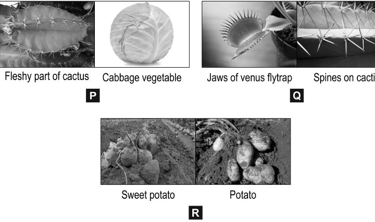Evidence of Common Ancestry and Diversity - Genetic information provides evidence of evolution. DNA sequences vary among species, but there are many overlaps;in fact, the ongoing branching that produces multiple lines of descent can be inferred by comparing the DNA sequences of different organisms. Such information is also derivable from the similarities and differences in amino acid sequences and from anatomical and embryological evidence.
Evidence of Common Ancestry and Diversity - Genetic information provides evidence of evolution. DNA sequences vary among species, but there are many overlaps;in fact, the ongoing branching that produces multiple lines of descent can be inferred by comparing the DNA sequences of different organisms. Such information is also derivable from the similarities and differences in amino acid sequences and from anatomical and embryological evidence.: Overview
This topic covers various concepts like Trilobite Fossils, , etc.
Important Questions on Evidence of Common Ancestry and Diversity - Genetic information provides evidence of evolution. DNA sequences vary among species, but there are many overlaps;in fact, the ongoing branching that produces multiple lines of descent can be inferred by comparing the DNA sequences of different organisms. Such information is also derivable from the similarities and differences in amino acid sequences and from anatomical and embryological evidence.
Which of the following maps contributed in the formation of human genome project?
Reptiles, salamander, lobe fins, frogs. Rearrange them in ascending order of the evolutionary tree.
Potato and sweet potato
What is Chromosome mapping?
Given below are different plant forms:
a. Rhynia-type plants
b. Seed ferns
c. Psilophyton
d. Tracheophyton ancestors
e. Progymnosperms
Choose the correct sequence of evolution of plant forms:
The geological conditions on primitive Earth about _____million years ago were much different from those found today.
Suggest why it is important that we can only consider fossils of living things that are now extinct as evidence of plate tectonics.
Before the Industrial Revolution, the black peppered moth was rare. During the early decades of the Industrial Revolution in England, the countryside between London and Manchester became blanketed with soot from the new coal-burning factories. Many of the light-bodied lichens died from sulphur dioxide emissions, and the trees became darkened. This led to an increase in bird predation for light-coloured moths, as they no longer blended in as well in their polluted ecosystem.
What could be an external factor that determines the return of the light-coloured moths?
Before the Industrial Revolution, the black peppered moth was rare. During the early decades of the Industrial Revolution in England, the countryside between London and Manchester became blanketed with soot from the new coal-burning factories. Many of the light-bodied lichens died from sulphur dioxide emissions, and the trees became darkened. This led to an increase in bird predation for light-coloured moths, as they no longer blended in as well in their polluted ecosystem.
What would have happened to the population of light-coloured moth over time and why?
Which of the following statements is correct?
Comparative anatomy and morphology studies deepened the understanding of evolution. The presence of analogous and homologous structures provides important evidence in the favour of evolution. Which of the following is/are examples of HOMOLOGOUS structures found in plants?

Which one of the following are analogous structures?
"Homo sapiens" implies:
The approximate gene contained in genome of Rajiv sir
Which of the following diagram does not correctly represent the convergent evolution?
Which of the following diagrams is not a correct representation of convergent evolution?
Darwin's finches are a good example of
Which pair does not show divergent evolution ?
Identify the correct statement-
Which of the following human ancestor is correctly matched with their cranial capacity?
